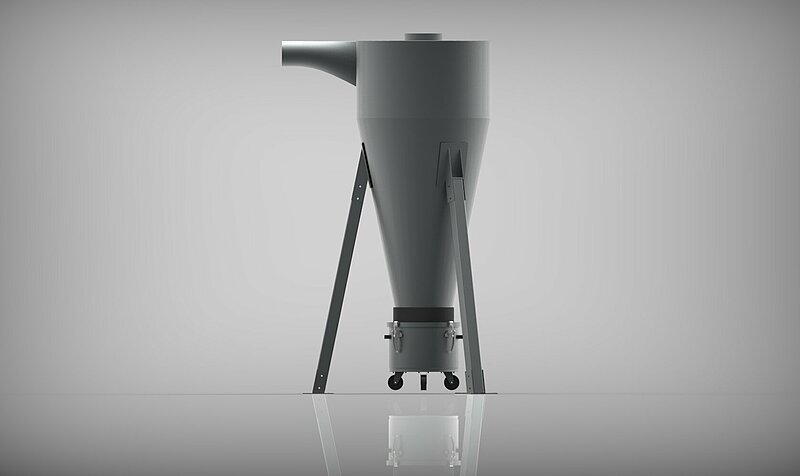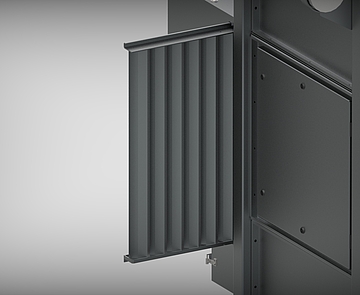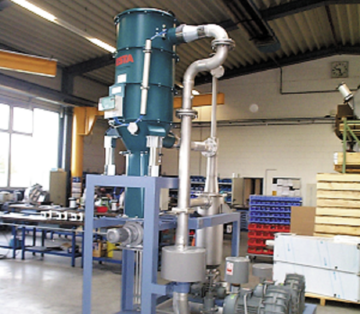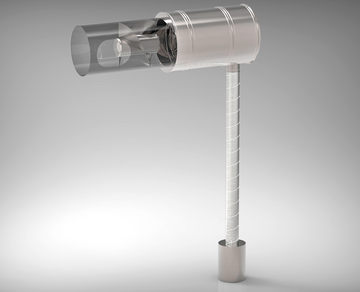WHAT IS THE FUNCTION OF A PRE-SEPARATOR AND WHAT TYPES ARE THERE?
A pre-filter or pre-separator has the task of protecting the actual main filter of an extraction system. The use of a pre-separator increases both the safety and the service life of the main filter.
The following main influences on the service life of the filter can thus be avoided or reduced:
- High to very high dust levels
- Abrasive substances
- Separation of hot and glowing particles and sparks
Since a pre-separator incurs no or only very low running costs, its use and the associated lower load can often significantly reduce operating costs.
CYCLONE SEPARATOR
WHEN DO I NEED A CYCLONE SEPARATOR?
Cyclone separators work on a purely physical basis and can be used both as a main and as a pre-separator in extraction systems. They separate coarse, dry, free-flowing dusts, have many uses and can be used for many dusts and also for fibres. The discharge can also take place continuously or discontinuously.
FUNCTION
The dust-laden airflow enters the cyclone tangentially in the upper third of the cyclone housing. The airflow around the central immersion tube causes the air to rotate, and the particles contained in the airflow are forced outwards in the direction of the cyclone housing. From there, they slide down the conical housing, where they are collected in a container or discharged through continuously operating discharging elements. The purified air rises to the outside via the immersion tube.
The better the design of the cyclone separator and the better it is adapted to the air volume flow and the material to be separated, the better its separation performance.

APPLICATION EXAMPLES
Cyclones can be used as a main or pre-separator.
As the main separator, cyclone separators achieve a very high degree of separation, especially with coarse materials, so that no further filter is required. When used as a pre-separator, cyclone separators ensure that larger particles are separated before they reach the downstream filter unit. As a result, the service life of the filter elements in the filter unit is often significantly extended. This in turn reduces the operating and maintenance costs.
In applications where sparks can be extracted, it also often makes sense to use a cyclone as a pre-separator. This reduces the likelihood of sparks or other sources of ignition entering the filter unit. Cyclone separators are the pre-separators recommended by IFA and VDS for extraction applications with flying sparks.
Cyclone separators can be used both on the suction as well as on the pressure side, i. e., the vacuum generator can be either before or after the cyclone. For applications with frequent material changes, the cyclone is also often the appropriate choice because it requires only a minimum amount of cleaning work.
ESTA’s ZA series cyclone separators are protected by a utility patent, and, thanks to their design, achieve a very high degree of separation. In addition, cyclone separators can also be used for the pre-separation of sparks to reduce the risk of a filter fire.
OTHER TYPES OF PRE-SEPARATORS
IMPACT SEPARATORS AND INERTIAL FORCE SEPARATORS
Another form of pre-separators is impact or inertial forces separators.
By using an impact separator, the speed of the particles in the airflow is reduced so much that they are no longer transported by the airflow and fall into a collection container. During pre-separation, coarse particles and sparks are separated from the fine dust particles. This reduces the dust load on the filter elements and significantly reduces the risk of a filter fire.
In inertial force separators, the different density of the air and the medium to be separated is used. They work without filter material and can be specially adapted for the respective application.

Integrated pre-separators are connected upstream of a filter system, for example. There are also pre-separators which can be used directly at the collection point or point of origin. The use of integrated pre-separators often aims to protect a system from sparks. This is done by extending the residence time and cooling time of the spark or by directly separating a potential spark. These may be impact or inertial force separators.

CLASSIFIERS
Classifiers are frequently used for materials with very different densities or for very light materials. They separate coarse fractions from fine fractions and are used, for example, in the cleaning of plastic granules in the recycling sector, or generally as separators upstream of filter units.
These substances can be separated by low flow speeds. Particular attention should be paid to the space required and the correct design.
ESTA offers counterflow classifiers, air classifiers and other alternatives suitable for the respective application.
WATER PRE-SEPARATORS AND SPARK PRE-SEPARATORS
Some pre-separators work with a contact medium such as water. A water pre-separator is especially indicated when flying sparks are expected. The system must be designed very precisely to ensure contact with the water.

ESTA PRE-SEPARATORS
BENEFITS OF ESTA PRE-SEPARATORS
- Optimal solution for the separation of medium and coarse problem dusts
- Effective dust separation with a very high degree of separation
- Ideal combination with extraction systems and dust extractors
- Low operating costs due to increased service life of the main filter
We are happy to put together a coherent extraction concept with you and adapt the system exactly to your needs. Just contact us! Our pre-separators are protected by a utility patent and, thanks to their design, achieve a very high degree of separation.
CONTACT
WE ARE HAPPY TO PROVIDE A PERSONAL CONSULTATION
We can adapt our exhaust installations to your needs. Tailor-made, modular and individual. Ask us!
